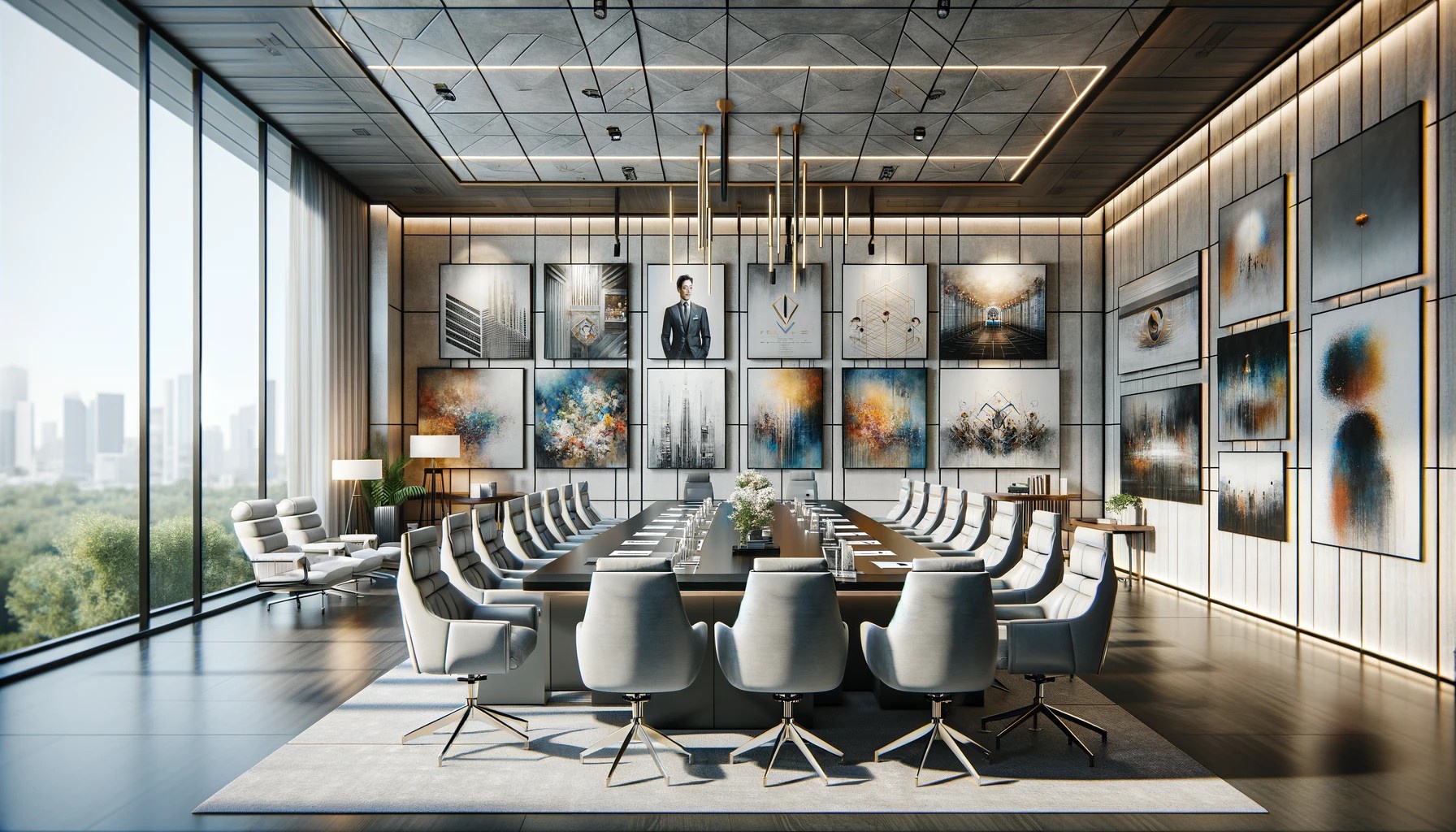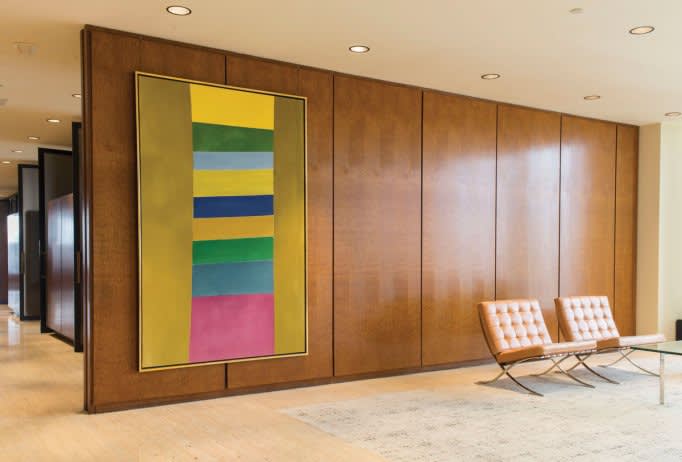
Did you know that some of the most prolific, high-quality art collections in the world belong to banks? For example, Deutsche Bank, one of the primary sponsors for Frieze art fair, has collected over 70,000 artworks over the years. But why are big businesses and corporations interested in collecting art? How did it all begin?
In this article, we will explore the historical context of art in corporate spaces, the strategic role of art in corporate identity, the financial and cultural benefits of art as an investment, the symbiotic relationship between corporate collections and emerging artists, and the evolving future of art in the corporate world. Through this exploration, we aim to illuminate the intricate dance between art and business and how this relationship continues to redefine the boundaries of corporate identity and cultural patronage.
What we’ll cover in this article includes:
- What corporate art collections are and their purpose in the business world?
- A brief history of how and why companies started collecting art
- The Role of Art in Shaping Corporate Identity
- Corporate Art Collection as an Investment Strategy and the risks involved
- How do Corporate Art Collections Support Emerging Artists?
- Case Studies of Successful Corporate Art Collections
- The Future of Corporate Art Collections
- Conclusion
If you are interested in starting a corporate collection or extending your existing one with works from African and diaspora artists? Contact us today!
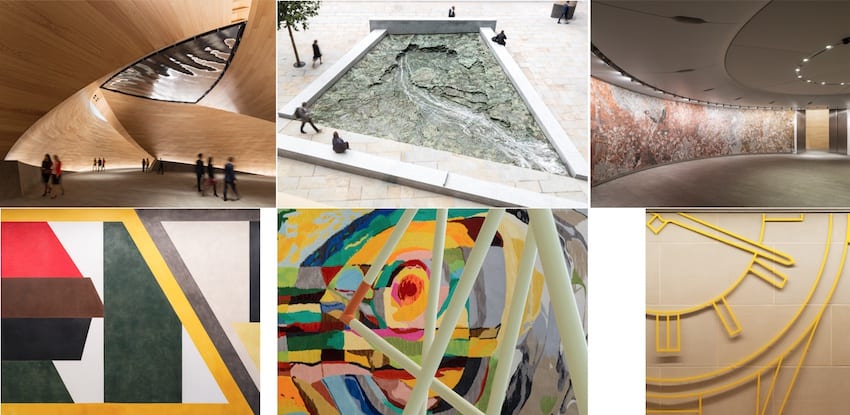 Artworks commissioned for the Bloomberg’s European headquarters. Artists include: Michael Craig-Martin, Olafur Eliasson, Arturo Herrera, Cristina Iglesias, David Tremlett and Pae White
Artworks commissioned for the Bloomberg’s European headquarters. Artists include: Michael Craig-Martin, Olafur Eliasson, Arturo Herrera, Cristina Iglesias, David Tremlett and Pae White
Now, let’s understand how, in corporate settings, art collections are a nuanced and impactful strategy, reflecting a company's values and enhancing its aesthetic appeal while showing commitment to culture and community.
What are corporate art collections?
At its core, a corporate art collection is an assemblage of artworks—ranging from paintings and sculptures to multimedia installations—acquired and displayed by a company. Companies often house these collections within their premises, making them accessible to employees, clients, and sometimes the public. They serve as an immersive gallery that reflects the corporate brand's ethos. The curation of these collections is a deliberate process, involving careful selection by art consultants, corporate curators, or committees dedicated to ensuring that the art resonates with the company's brand, cultural values, and aesthetic vision.
There are many reasons why businesses start art collections, which extend beyond mere aesthetics. Businesses often hire art advisors to select and manage collections, often with an ulterior purpose in mind. UBS and Deutsche Bank, for example, have made art collecting a core aspect of their corporate identity. The pursuit of art often aligns large companies with a cultural sensitivity, or even philanthropy, boosting the overall public image of the business.
Art collections are a tangible representation of a company's investment in culture, creativity, and the well-being of its employees and community. Art in the workplace has been linked to enhanced creativity, reduced stress, and increased productivity among employees. It transforms mundane work environments into dynamic and inspiring spaces, fostering an atmosphere of innovation and open-mindedness.
Besides internal benefits, corporate art collections can significantly affect external perceptions. Clients, partners, and visitors who encounter these collections may perceive the company as more sophisticated, culturally aware, and intellectually engaged, factors that can subtly influence business relationships and brand perception. This strategic alignment of art with business identity not only enriches the corporate culture but also positions the company as a forward-thinking, innovative, and culturally engaged entity in the global marketplace.
The Historical Context of Art in Corporate Spaces
Corporate art collections are not a modern concept but rather an evolved practice with deep historical roots, tracing back to the Renaissance era. The first corporate art collection can be traced as far back as 1472, when Monte dei Paschi began collecting for his bank in Siena, Italy. At the time, affluent patrons supported artists not just for personal enjoyment but as a testament to their wealth, power, and cultural sophistication.
As we transitioned into the 20th century, the concept of art in the workplace took a more structured form with the emergence of corporate art collections. Companies started to recognize the value of creating an aesthetically pleasing work environment and the positive impact it had on employee morale, client perceptions, and overall brand image. It was during this period that art in corporate settings began to be seen not just as decoration but as a strategic element of corporate identity and branding.

Benvenuto di Giovanni, Madonna of Mercy fresco, 1472, Banca Monte dei Paschi di Siena headquarters
The trend of corporate collecting as we know it today, however, broadly began in the post-war economic boom of the 1950s. That era saw a significant increase in corporate art collecting, particularly among banks, law firms, and large corporations in the United States and Europe. David Rockefeller, who began acquiring artworks for Chase Manhattan Bank (now JP Morgan Chase), and Thomas J. Watson Jr. at IBM, were pioneers in this movement. Shortly afterward, other banks began buying the artworks of famous contemporary artists such as Andy Warhol, Sol LeWitt, and Barbara Kruger, to name just a handful.
The 1980s and 1990s saw a further evolution of corporate art collections, with companies becoming more adventurous in their selections, incorporating contemporary and avant-garde works into their collections. This period also marked a shift towards using art collections to enhance corporate image and engage with wider societal and cultural discussions. Art became a medium for companies to express their values, engage with social issues, and foster a sense of community and cultural appreciation among their employees and clients.
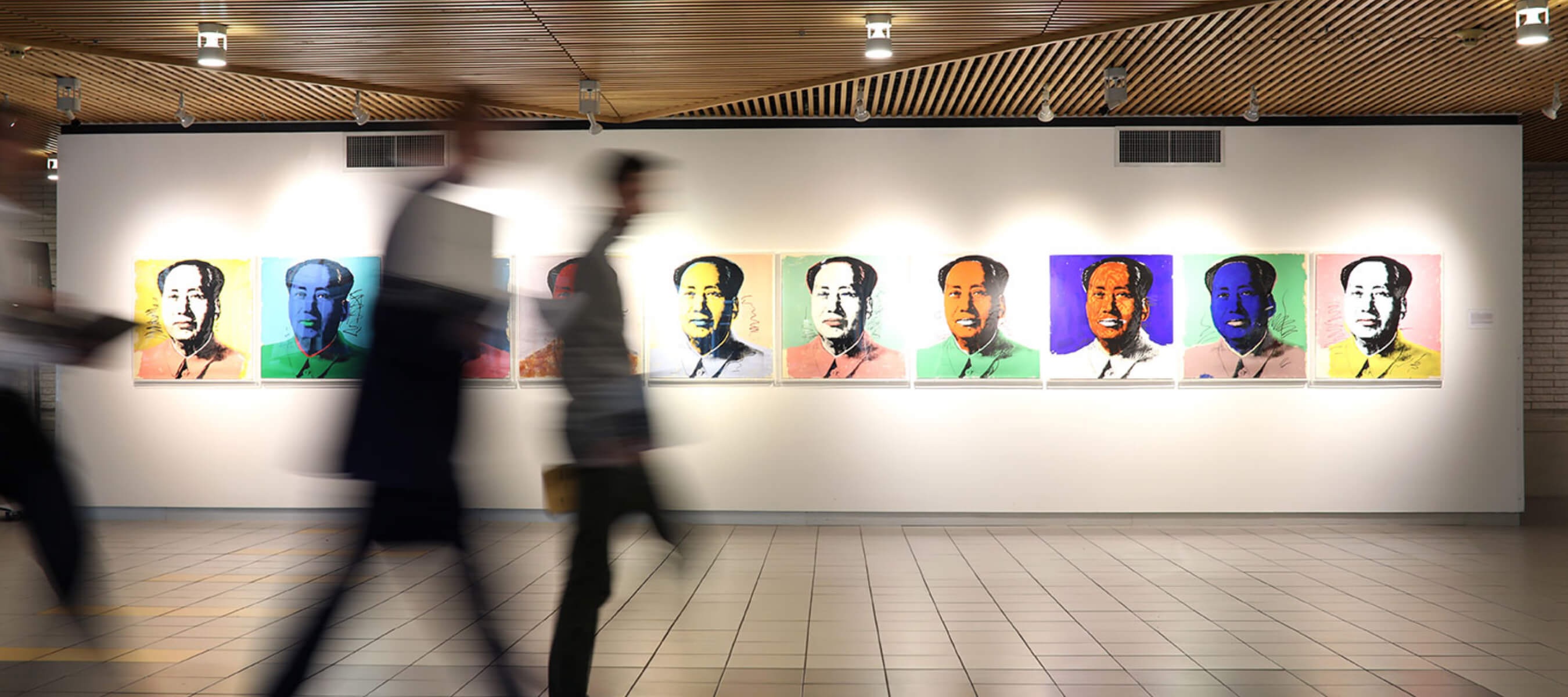
Progressive art collection. Source: Progressive
Today, the historical context of corporate art collecting continues to influence modern practices, with companies increasingly recognizing the value of integrating art into their corporate spaces. This tradition not only enriches the aesthetic environment but also serves as a testament to a company's commitment to culture, creativity, and social responsibility.
The Role of Art in Shaping Corporate Identity
Art within corporate spaces does far more than adorn walls and fill empty corners; it serves as a silent yet powerful communicator of a company's identity, ethos, and vision. The strategic selection and placement of art in corporate environments can significantly influence both employee and client perceptions, shaping the narrative around what the company stands for and how it wishes to be perceived in the wider business landscape.
Reflecting Corporate Values and Culture
The art a company chooses to display is a reflection of its corporate culture and values. Abstract, innovative pieces may suggest a company values creativity and forward-thinking, while classic, historical works might indicate respect for tradition and stability. This visual representation of a company's identity helps to foster a sense of belonging and pride among employees, reinforcing the company's values daily.
Enhancing Brand Image and Client Experience with Art
For clients and visitors, the art collection introduces the company's brand image before a single word is exchanged. A well-curated corporate art collection can elevate a company's stature, suggesting a level of sophistication, success, and attention to detail that speaks volumes about its business practices and client relationships.

Stimulating Creativity and Innovation: The Power of Art in Design
One of the most notable results of having art in an office space is an active promotion of creative thinking and the elevation of mood and positivity in the workplace, making employees more engaged and productive. By introducing diverse visual elements into the work environment, companies can encourage employees to think more broadly and approach challenges with a fresh perspective.
Global Connectivity and Diversity
For global companies, art can serve as a bridge between diverse cultures, showcasing works from around the world to reflect the company's international presence and commitment to inclusivity. This not only enriches the corporate environment, but also demonstrates respect and appreciation for different cultural perspectives.
In summary, art in corporate spaces is a strategic asset that reflects and shapes corporate identity, influences perceptions, and fosters an environment of creativity and innovation.
Corporate Art Collection as an Investment Strategy
In the sophisticated arena of corporate finance, art collections have emerged not only as symbols of cultural engagement and aesthetic appreciation but also as strategic financial assets. If done carefully, art collecting can serve as a unique investment avenue, offering both tangible and intangible returns.
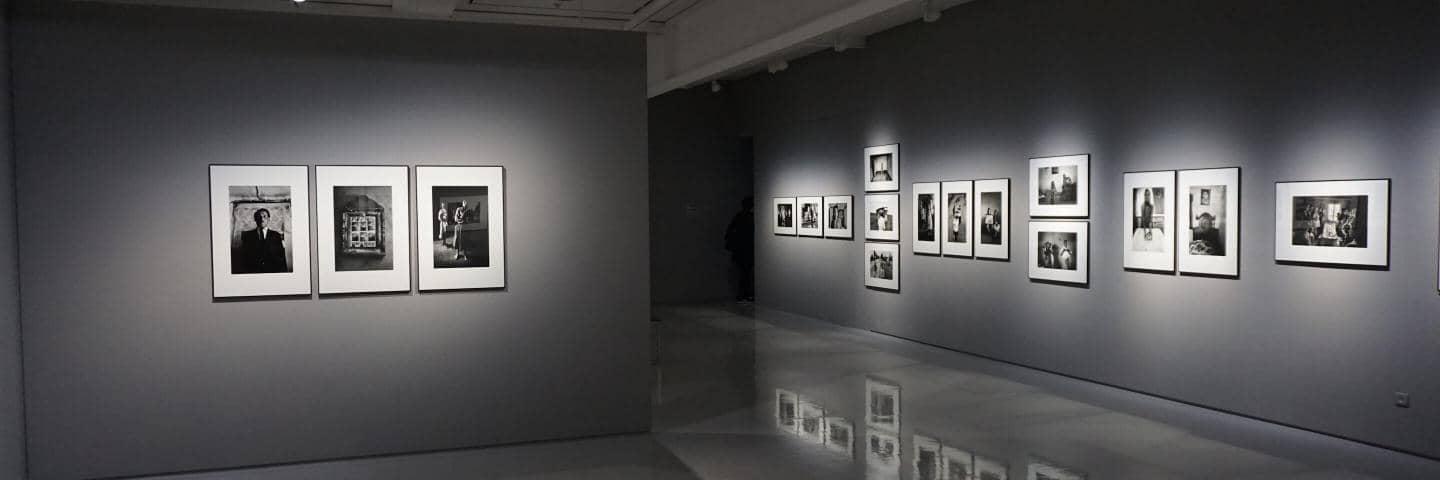
Image: Barclays Bank
Financial Appreciation
One of the most direct benefits of a corporate art collection is the potential for financial appreciation. Similar to other investments, art can appreciate in value. Corporations that are savvy in acquiring pieces with potential for appreciation can see significant returns, particularly with works from emerging artists who gain prominence or historical pieces that become rarer over time.
For instance, The JP Morgan Chase corporate art collection, founded over 60 years ago as a $500,000 investment, is estimated to be worth more than $100 million, according to the collection’s founder, David Rockefeller, in a memoir [1]. While the specific financial appreciation over time is not provided, the substantial value of the collection shows significant financial appreciation.
Diversification of Investment Portfolio
For corporations, diversifying investment portfolios is crucial to mitigating risk, and art can offer a unique asset class that is uncorrelated with traditional market instruments like stocks and bonds. This means that even in times of market volatility, art can maintain or even increase its value, providing a stable investment amidst economic fluctuations.
Investment-grade art, such as that found in corporate art collections, often experiences lower price volatility and offers rewards that extend beyond financial gains [2].
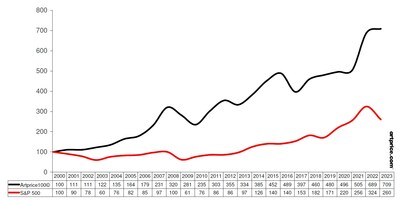
Artprice100© (100 most successful artists) vs. S&P 500 – Base 100 in January 2000, courtesy of Artprice
Tax Benefits and Corporate Philanthropy
Investing in art can also offer certain tax advantages, such as deductions for charitable donations if the art is loaned to museums or public institutions. Supporting the arts can be a part of a corporation's social responsibility initiatives, enhancing its reputation as a patron of culture and community engagement.
Risks and Considerations
While the benefits are compelling, investing in art also comes with its own set of challenges and risks. The art market can be unpredictable, and values can fluctuate based on trends, artist recognition, and market demand. Moreover, maintaining and conserving art requires specialized knowledge and can incur significant costs. As such, corporations need to approach art investment with a well-considered strategy, expert advice, and a clear understanding of the art world.
How Corporate Art Collections Support Emerging Artists
Corporate art collections play a pivotal role in the art ecosystem, not only by enhancing corporate spaces but also by providing critical support to emerging artists. This patronage can be transformative, offering artists visibility, validation, and financial backing that might otherwise be difficult to secure. The symbiotic relationship between corporations and artists fosters a dynamic cultural landscape within the corporate sector and the broader art community.
On the company’s side, great satisfaction can come from supporting talented young artists who are struggling to launch their careers, or artists from disadvantaged or minority backgrounds who are underrepresented in the art world. The effort to support these artists by acquiring their works can be a genuine unifying element within the company as well, as employees can feel a stronger connection to the business and a sense of pride knowing that they work for a company that is actively supporting the arts.
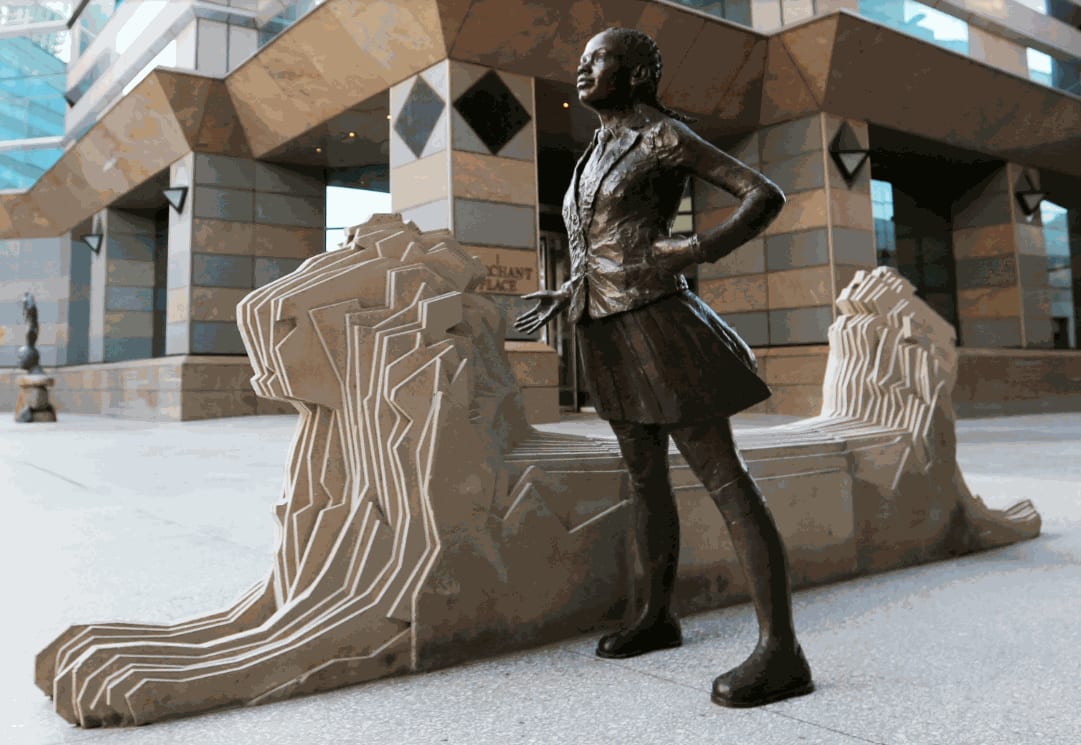
Marieke Prinsloo-Rowe, Africa’s Fearless Thinker, commissioned by RMB
Offering Visibility and Exposure
One of the most significant ways corporate collections support emerging artists is by offering them visibility and exposure. Displaying their work in prominent corporate settings allows artists to reach audiences beyond traditional art spaces, such as galleries and museums. This exposure can help to build an artist's reputation and expand their professional network.
Financial Support and Stability
Purchasing artworks from emerging artists provides them with essential financial support, contributing to their livelihood and enabling them to continue their artistic endeavors. This financial injection can be crucial for artists at the early stages of their careers, where funding and resources are often limited.
Validation and Credibility
When a corporation acquires an artist's work, it serves as a form of validation and adds credibility to his portfolio. This endorsement can be a significant career milestone, opening doors to further opportunities, such as gallery representation, commissions, and inclusion in prestigious exhibitions.
Encouraging Diversity and Innovation
Corporate collections often strive for diversity in their acquisitions, which encourages a broad range of artistic expressions and innovations. This diversity not only enriches the corporate art collection but also promotes cultural inclusivity and supports an array of artistic voices and perspectives.
Creating Long-Term Relationships
Some corporations go beyond single acquisitions, building long-term relationships with artists through commissions, residencies, and ongoing collaborations. These partnerships can provide sustained support and engagement, offering artists platforms for growth and development.
In essence, corporate art collections serve as a vital bridge between the business world and the art community, offering emerging artists a platform for recognition and success. Through their support, corporations contribute to a vibrant cultural environment, fostering creativity and innovation while enriching their own spaces and identities.
Case Studies: Successful Corporate Art Collections
Exploring successful corporate art collections offers valuable insights into how businesses can effectively integrate art into their corporate identity and environment. These case studies highlight the strategic approaches some companies have taken to curate collections that not only enhance their workspaces but also embody their brand values and support the broader art community.
Deutsche Bank: A Pioneering Corporate Collection
Deutsche Bank boasts one of the world's largest corporate art collections, with over 60,000 artworks displayed across its offices globally. The collection emphasizes works on paper and photography by emerging artists, reflecting the bank's commitment to contemporary art and cultural dialogue. Deutsche Bank's approach shows how a corporate collection can act as a cultural ambassador, fostering an environment of creativity and innovation.
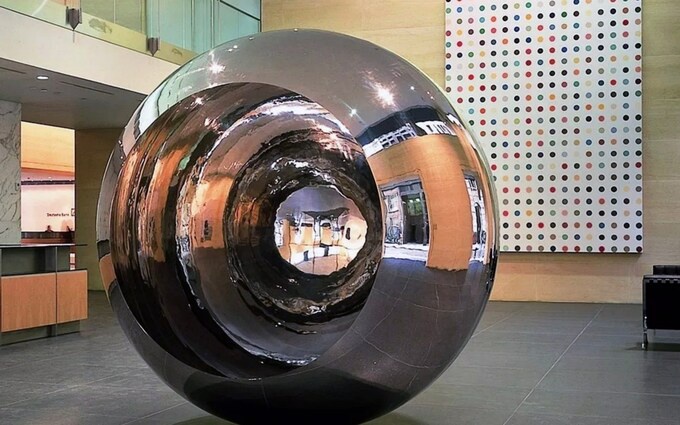
Deutsche Bank London’s reception features art by Anish Kapoor and Damien Hirst. Photograph: Deutsche Bank
JP Morgan Chase Art Collection: Blending Tradition and Modernity
The JP Morgan Chase art collection, one of the oldest and most extensive corporate collections in the world with some 30,000 works, started in the late 1950s. It includes a wide range of artworks, from historical pieces to contemporary art, showcasing the bank's diverse and inclusive approach to art patronage. The collection serves as a testament to the company's long-standing commitment to cultural investment and employee engagement.
UBS Art Collection: A Global Perspective on Art
The UBS Art Collection comprises over 30,000 pieces, including works by some of the most significant artists of the 20th and 21st centuries. UBS's collection strategy focuses on acquiring works that reflect a global perspective, underscoring the company's international presence and its commitment to cultural diversity and understanding.
Nandos’ Art Collection is one of the biggest African art collections
The company has been supporting South African art since one of its stakeholders, South African Richard Enthoven, proposed the initiative. Enthoven also has a private collection of higher value contemporary South African artworks, but among the Nandos restaurants themselves, over 22,000 works have been collected and are displayed publicly across 1,094 restaurants globally, making it perhaps one of the largest (if most discreet) collection of African artworks on display.
These case studies exemplify the multifaceted benefits of corporate art collections, from enhancing corporate environments and supporting artists to embodying a company's values and fostering a creative and inclusive culture.
The Future of Corporate Art Collections
As we navigate the evolving landscape of the corporate world, the role and relevance of art collections within this sphere are also undergoing significant transformation. Emerging trends and technological advancements shape the future of corporate art collections, and changing societal values, all of which play a crucial role in determining how art continues to integrate into the corporate identity and environment.
Embracing Digital and Interactive Art
The rapid advancement of technology has paved the way for digital and interactive art forms to become an integral part of corporate collections. Augmented reality (AR), virtual reality (VR), and interactive installations offer additional dimensions of engagement, allowing employees and visitors to experience art in dynamic and immersive ways. This trend not only reflects the technological ethos of modern businesses but also caters to a growing desire for interactive and experiential content.
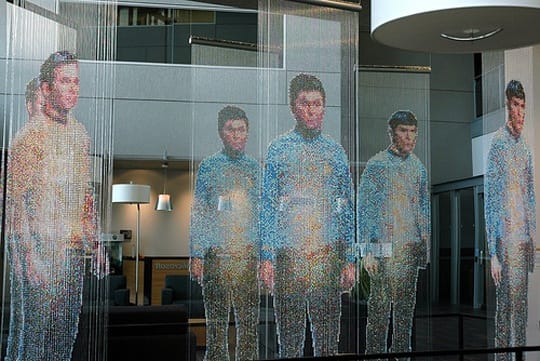
Devorah Sperber, Spock, Kirk and McCoy: Beaming-In, 2008, Microsoft Headquarters, Redmond, Washington. Microsoft Art Collection. Artist’s website.
Sustainability and Social Responsibility
There's a growing emphasis on sustainability and social responsibility in all aspects of business, including corporate art collections. Companies are increasingly curating collections that reflect social, environmental, and ethical themes, aligning with broader corporate responsibility goals.
Supporting Diversity and Inclusion
Corporate art collections are becoming platforms to promote diversity and inclusion by showcasing works from underrepresented artists and cultures. This approach not only enriches the collection with a variety of perspectives and styles but also reinforces a company's commitment to inclusivity and global connectivity.
The Role of NFTs and Blockchain
The rise of non-fungible tokens (NFTs) and blockchain technology has introduced a new frontier for corporate art collections. NFTs allow for the ownership and display of digital art in unique ways, offering a blend of innovation, security, and exclusivity. This trend is appealing to companies in the tech sector, looking to integrate cutting-edge technologies into their corporate culture.
Art as a Tool for Wellbeing and Engagement
The future of corporate art collections also sees a stronger focus on the well-being and engagement of employees. Art is increasingly recognized for its therapeutic qualities, with collections curated to create calming, inspiring, and thought-provoking environments. This shift reflects a broader recognition of the importance of mental health and well-being in the workplace.

Art+Yoga with Marley Rae at MOCA. Photo by Kavi Peshawaria
Conclusion
As we've explored the multifaceted world of corporate art collections, it's clear that these collections are much more than mere decorative elements. They are powerful tools for shaping corporate identity, fostering a culture of creativity and innovation, and reflecting a company's values and ethos. They reflect a company's commitment to cultural enrichment, employee well-being, and social responsibility. As we've seen through various case studies, successful corporate collections can profoundly influence both internal and external perceptions of a company, offering a unique blend of cultural and financial value.
Looking to the future, integrating art in corporate spaces promises to be even more dynamic and impactful. With digital art, interactive installations, and a growing focus on diversity and sustainability, corporate art collections will continue to develop, mirroring the changing values and advancements of our society.
Want to start a corporate collection or extend your existing one? Pavillon54 helps both new and existing collectors with building their art collection to include artworks from African, diaspora, and black artists. We conduct fresh research for every client, working with diverse budgets, commissioning works from diverse sources, and overseeing the commissioning process. Contact us today!
Images:
Michael Craig-Martin Lexicon Located on the walls of floors 2, 3 and 4. Photo credit: James Newton
Olafur Eliasson No future is possible without a pastLocated in the Vortex on the ground floor and at the base of the ramp on the 2nd floor. Photo credit: James Newton
Cristina Iglesias. Forgotten Streams. Located in two of the public plazas around the site. Photo credit: Nigel Young/Foster + Partners
Isabel Nolan Another View from Nowhen Photo credit: David Morgan
David Tremlett City Drawing #1 Located in the south building reception hall and elevator lobby. Photo credit: James Newton
Pae White Pomona Located on the ground floor in the auditorium’s pre-function space. Photo credit: James Newton

